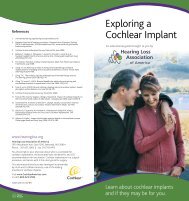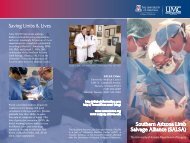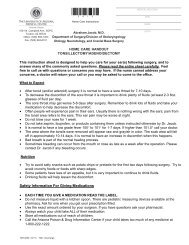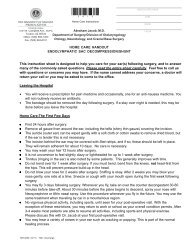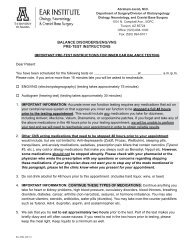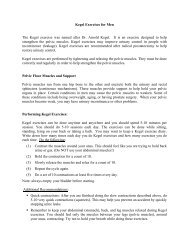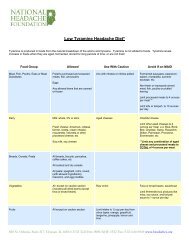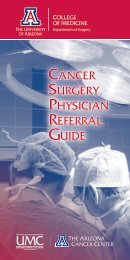Volume 10, Issue 1, 2011-2012 - Department of Surgery - University ...
Volume 10, Issue 1, 2011-2012 - Department of Surgery - University ...
Volume 10, Issue 1, 2011-2012 - Department of Surgery - University ...
- No tags were found...
Create successful ePaper yourself
Turn your PDF publications into a flip-book with our unique Google optimized e-Paper software.
hand, or finger – cansignificantly impactquality <strong>of</strong> life. A loss<strong>of</strong> function in one<strong>of</strong> these areas is adevastating blow torecovery and to anyhope <strong>of</strong> returning toa normal life.As members <strong>of</strong>the Division <strong>of</strong> Reconstructive andPlastic <strong>Surgery</strong>, Warren BreidenbachIII, MD, Tolga Turker, MD, and JiyaoZou, MD, specialize in microsurgicaltransfer <strong>of</strong> bone, tissue, and nerve, aswell as free or pedicled skin flaps torepair wounds, injuries, or defects tothe upper extremities and to restoresensation and movement. They also aretrained to perform composite tissue allotransplants(the transplantation <strong>of</strong> tissueor limbs from deceased donors).Whether their patients come inelectively or with trauma, these surgeonshave the combined skills <strong>of</strong> reconstructive,plastic, and vascular surgeons, eliminatingthe need for multiple providersand resulting in less duplicated care andshorter recovery time. They have particularexpertise in the treatment <strong>of</strong> all types<strong>of</strong> hand surgeries, including transplantinghands and replanting severed digits.“Restoring function is our numberone priority,” said Dr. Zou. “After anaccident, we are able to save a patient’sthumb or finger by performing a replantation,which includes bone fixation andtendon, artery, and nerve repair.“We use a vein graft from the forearmin order to keep the length <strong>of</strong> thedigit. If the digit is not replantable, aswith a fingertip injury, we can salvagethe finger’s length usingdifferent kinds<strong>of</strong> flaps,” Dr. Zouexplained.Other types <strong>of</strong>miscrosurgical reconstructionon extremitiesperformed byDrs. Zou and Turkerinclude woundcoverage.“We can use both pedicled and freeflaps to cover the tissue defects. Flapcoverage can be successfully done andwill provide a better outcome with severeupper extremity injuries,” saidDr. Turker.Drs. Zou and Turker were broughton board by Dr. Breidenbach, the newchief <strong>of</strong> the Division <strong>of</strong> Reconstructiveand Plastic <strong>Surgery</strong>.Dr. Breidenbach came to the UA fromthe Christine M. Kleinert Institute forHand and Microsurgery in Louisville,Ky., where he performed the world’s firstsuccessful complete hand transplant. Heis interested in expanding the types <strong>of</strong>transplants performed at the UA to otherareas <strong>of</strong> the body, including face transplants.“There’s always been a need forthis kind <strong>of</strong> specialized microsurgicalrestoration,” Dr. Breidenbach said. “Wenow have highly qualified hand surgeonsavailable 24/7.”Breast <strong>Surgery</strong>Unlike some <strong>of</strong> the other areas <strong>of</strong> thebody where microsurgery techniques areused, form outweighs function in breastreconstruction.Ethan Larson, MD, in the Division<strong>of</strong> Reconstructive and Plastic <strong>Surgery</strong>,<strong>of</strong>fers state-<strong>of</strong>-the-art microsurgery breastreconstruction techniquesafter mastectomy to helpwomen recovering frombreast cancer begin to feelwhole again.DIEP (deep inferiorepigastric perforator) andTUG (transverse uppergracilis) flap proceduresuse skin, tissue, and tinyblood vessels taken fromeither the patient’s abdomenor inner thigh areato form a new breast. The breast reconstructionflaps are much larger than mostother flaps used in other microsurgicalprocedures, but the technical aspects arenot so different from other areas <strong>of</strong> thebody, Dr. Larson said. These particularflaps are <strong>of</strong>ten made up <strong>of</strong> the patient’sown skin and fat, without the need tosacrifice a functional muscle.“The surgery itself is quite lengthy,so completing the dissection <strong>of</strong> the flapin a timely fashion is <strong>of</strong>ten the mostdifficult portion <strong>of</strong> the procedure, alongwith the added challenge <strong>of</strong> shaping anattractive breast from abdominal tissue– one that matches a remaining breast,”he said.Dr. Larson is one <strong>of</strong> the few surgeonsin Southern Arizona to <strong>of</strong>fer microsurgicalfree-flap breast reconstruction. “I doall types <strong>of</strong> microsurgery, but breast reconstructionseems to answer the biggestneed,” he said.DIEP andTUG flapproceduresuse skin,tissue, andtiny bloodvesselstaken fromeither theabdomen orinner thighto form anew breast.3





